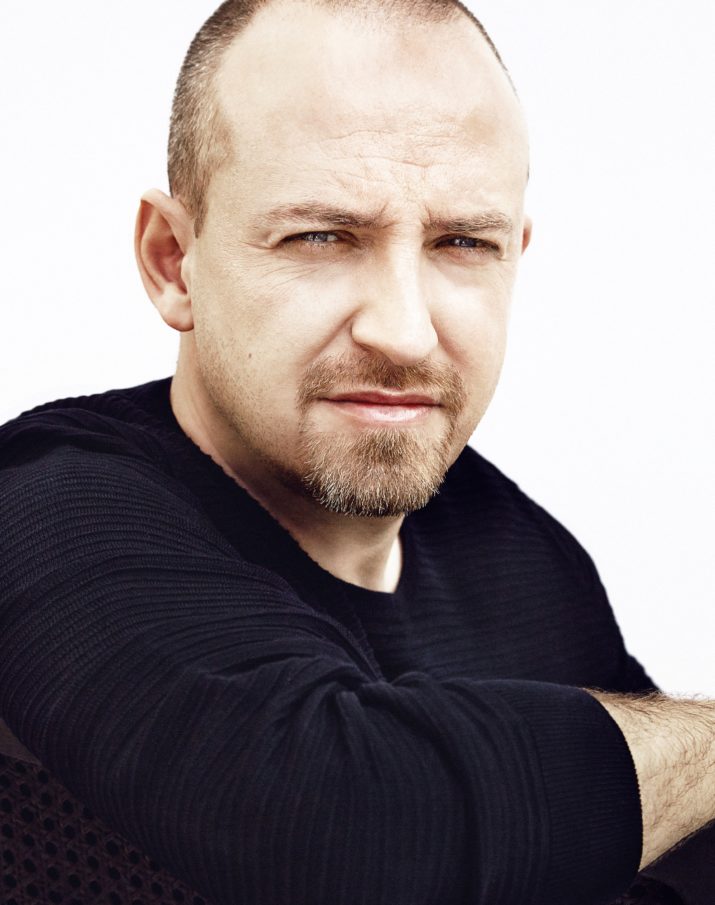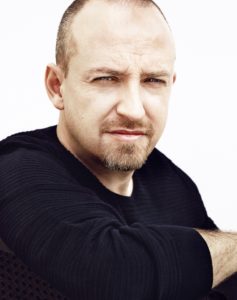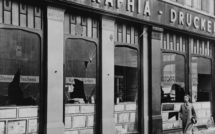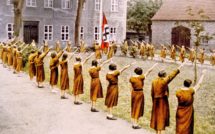

This is part of our special feature on Crime and Punishment.
Translated from the Spanish by H.J. Gardner.
The Institució de les Lletres Catalanes and the Institut Ramon Llull have designated Esteve Soler as one of the Catalan authors with the greatest international dissemination, given that his plays have been translated into nineteen languages and performed in theatres across the globe. His Indignation trilogy (2007) includes the works Against Progress, Against Love and Against Democracy. His more recent Revolution trilogy (2017) features Against Freedom, Against Equality and Against Fraternity. In each play, seven short and seemingly unrelated scenes tackle issues of identity, agency, relationship and responsibility, paying homage to the traditions of Grand Guignol, surrealism or the theater of the absurd. In Scene One from Against Freedom, the European response to the global refugee crisis is portrayed with apparent indifference via the symbiotic relationship between a mother and child, allowing the contradictory impulses for nurture and punishment, self-congratulation and shame, to become apparent as the crisis between the two characters on opposite sides of the fence unfolds.
—H.J. Gardner for EuropeNow
1.
A fence separating one country from another in Europe. On one side, MOTHER, about 45 years old; on the other side, her SON, about 20 years old. They are connected to each other by the umbilical cord that supplies nourishment to the fetus. The cord is still functioning, moving nourishment from one body to the other. MOTHER is dressed as an ordinary citizen of a great nation and SON as a refugee migrant. MOTHER goes up to the fence as SON sleeps on the ground.
MOTHER: If only you knew how much I wish I could hug you.
Pause. SON wakes.
SON: Mother?
MOTHER: Come here.
SON stands and they hold hands through the fence.
MOTHER: If only you knew how much I wish I could hug you.
SON: I know, me too…
Brief pause.
MOTHER: Have you eaten?
SON: Of course I have… You know I never stop eating.
The fluid in the cord grows more intense during this exchange.
MOTHER: Remember, it’s for your own good.
SON: I know.
MOTHER: You’re not cold here, are you?
SON: No, I got the firewood and the winter clothing.
MOTHER: That’s good…
SON: Do you know when they’re going to let us in?
MOTHER: That’s why I came.
SON: It is?
MOTHER: Yes, everything’s been arranged, you’ll be able to enter soon.
SON: Really?
MOTHER: Yes.
SON: They’re not going to deport us?
MOTHER: No.
SON: But I’ve seen them taking everyone away, abandoning them to their own devices, stripping them of everything they have, confining them while the gangs rob them blind, and kill their children and rape their women…
MOTHER: Can I tell you something?
SON: Of course.
MOTHER: On March 8, 1994, in a speech to the European Parliament, Václav Havel, President of the Czech Republic, declared that Europe needed a charter specifying what it meant to be European—the so-called “Charter of European Identity” for the next era of a planet struggling to take command of its imminent and inevitable unification. Europe should be a community of values and the mother of revolutions for the modern world given the tolerance, humanity, and fraternity it has spread across the globe. Europe invented nations, and this was Europe’s moment to invent humanity. Europe could not be European if it did not guarantee that the entire world acquired its European values.
SON: Is that why we’re here?
MOTHER recites slowly.
MOTHER: On this side of the fence you can find Cézanne’s apples, the mist of Prague in Kafka, Beethoven’s Fifth, the Moscow desired by Chekhov’s Three Sisters, the circle of the dead in The Seventh Seal, Aristotle and the arousal of pity, Rita Levi-Montalcini’s In Praise of Imperfection, the Brandenburg Gate, memory in Pinter, Hypatia of Alexandria, the search for God in Bach, Picasso redefining art, Eiffel, time in Mrs. Dalloway by Virginia Woolf, irony in Oscar Wilde, the night that inspired Mary Shelley, Marcel Marceau, the Acts of the Apostles of Saint Paul, the Divine Comedy of Dante and the Human Comedy of Balzac, the sunflowers of Van Gogh, the “esperpentic” Madrid of Valle Inclán, Tarkovsky speaking to humankind from Solaris, Perestroika, the timidity of Jane Austen’s protagonists, black and white in Cartier-Bresson, nature in Gaudí, Orlando
Furioso by Ariosto, the intensity of Jacques Brel, The Scream by Munch, the white faces of Roy Andersson, the Olympics, Tolstoy’s nonviolence, Oxford, the fountain of Duchamp, the “verde que te quiero verde” of García Lorca, the Mona Lisa, Spinoza equating God to nature, Don Quijote’s love of reading, Charlie Rivel, the divine contradictions of Pasolini, Galileo Galilei and the universe, human flesh in the paintings of Francis Bacon, the holy for Leni Reifenstalhl, Vitosha mountain over Sofia, The Empty Space of Peter Brook, the legs of elephants in Dalí, Das Kapital by Marx, Healthcliff’s coldness in Wuthering Heights, Stendhal, Plato’s cave, the Louvre, the fragility of reality in Calderón de la Barca, gender in Sophie Calle, Vienna’s Concert for New Year’s Eve, the continental perspective of Malaparte, Chaplin eating his shoe in The Gold Rush, the Acropolis in Athens, Voltaire and justice, deduction in Descartes, the horror of Africa according to Conrad, the light in Rembrandt, Chanel, the theory of relativity, the Renaissance, Saint Stephen’s Basilica in Budapest, Shakespeare and mimesis, abstract emotion in Pina Bausch, the Requiem by Mozart, the absence of meaning in Polanski, the purity of colors in Matisse, Florence Nightingale caring for the sick, Baudelaire’s other beauty in The Flowers of Evil, Beckett before the impossible end in theater, the Mediterranean, its balanced diet, the Clair de Lune by Debussy, youth in Death in Venice by Thomas Mann, Saint Peter’s Basilica, the fatality of love in Racine, the open spaces of Le Corbusier, the technique of Maria Callas, Pavese’s “Death will come and will have your eyes,” Oktoberfest, the lost children of Dickens, the irresistible life of Fellini, the Baroque, the sexual angels of Paradise Lost, the plague in Manzoni’s The Betrothed, Molière or “laughing corrects morals,” the mysticism of Saint Teresa, Krakow’s Main Market Square, the Ring Cycle of Wagner, the Three Colors Trilogy by Kieślowksi, the “I know one thing: that I know nothing” of Socrates, Bowie’s strange changes, the death of Marie Curie, Christ as seen by Petrarch, the lochs of Scotland, abstraction in Kandinsky, Laurence Olivier, Proust’s madeleine, Stockholm’s Royal Dramatic Theater, human intelligence in Boccacio’s Decameron, Tesla and electricity, Handel’s Messiah, happiness in Renoir, the Duomos of Milan and Florence, the drunkenness of Brecht’s Mr. Puntila, the loners of Bernhard, the qualities of “The Man Without Qualities,” the courage of Nietzsche, the “under all skies, happiness is always somewhere else” by Leopardi, the Alps, Archimedes, the atmosphere of a Turner, Schiller leaving Mary Stuart, V for Vendetta, the Spanish sojourn of Lord Byron, epicureanism, Godard and his morals, Swan Lake, the Nude Maja, truth for Anna Politkovskaya, Bram Stoker’s Transylvania, Pirandello’s seventh character, evolution for Darwin, Velázquez reflected in Las Meninas, childhood in Jonathan Swift’s Modest Proposal, Saramago’s Blindness, Anne Frank’s house in Amsterdam, the diners trapped in Buñuel’s The Exterminating Angel, Hegelian dialectic, masculinity for Armani, the Beatles’ revolution, daily life as portrayed in Rilke, the recipes of Michel Bras, a nocturne by Chopin, Hagia Sophia in Istanbul, Friday in Defoe’s Robinson Crusoe, gravity and Newton, Cambridge, the night of Molly Bloom in Joyce’s Ulysses, Joan of Arc, the Trevi Fountain, the shadows of Caravaggio, Rodin’s Thinker, Kant’s Critique of Pure Reason, Verdi and La Traviata, the marionettes of Kleist, the Atomium of Brussels, obsession according to Hitchcock, the humanity of Rabelais’ Gargantua, the Cannes Film Festival, Strauss’s Blue Danube,
Paganini’s technique on violin, the Hermitage, bicycles in Copenhagen, Flaubert meeting death at the end of Madame Bovary, red for Valentino, Faust’s quest for knowledge in Goethe, the Roman Colosseum, The Lubitsch Touch, the “where they have burned books they will also ultimately burn people” of Heine, the middle class in Goldoni, Dreyer and transcendence, Hymns to the Night by Novalis, “Man is good by nature” by Rousseau, the Sistine Chapel, Cosette in Victor Hugo’s Les Misérables, Vivaldi’s Four Seasons, Saint Thomas Aquinas and the need for a God.
Brief pause.
SON: I won’t forget. I won’t forget any of this.
MOTHER: Remember it’s for your own good.
SON: I know.
MOTHER: We will always be together.
SON: I love you.
MOTHER: If only you knew how much I wish I could hug you.
MOTHER approaches the fence and manages, after a struggle, to stretch her arms through. She gives her SON a friendly hug with the fence separating them. Pause. MOTHER takes the umbilical cord and wraps it around the neck of her SON without him noticing.
MOTHER: Remember it’s for your own good.
MOTHER backs away and pulls the cord until she has strangled her SON.
Pause.
SON falls to the ground along with MOTHER, spent from the effort.
Brief pause.
The fence opens and MOTHER struggles to drag SON offstage using the umbilical cord.
Blackout.
***
Info on the 2018-19 performances in Vienna of “Against Freedom” is available here.
Esteve Soler’s plays have been translated into 19 languages and have been performed in countries such as Germany, United States, England, Switzerland, Greece, Romania, Brazil and Mexico, among others. His work is comprised of the Indignation trilogy (2007) – Against Progress, Against Love and Against Democracy – and the Revolution trilogy (2017) –Against Freedom, Against Equality and Against Fraternity. In 2010, the Institució de les Lletres Catalanes and the Institut Ramon Llull designated Esteve Soler as one of the Catalan authors with the greatest international dissemination. For more about Soler’s works, click here.
H.J. Gardner is a graduate of the Iowa’s Writers Workshop where she also translated for The International Writing Program. In 2010, she began translating the dramatic works of Esteve Soler for a contemporary American audience for the Seventh Annual Prelude Festival’s “Spotlight: Catalonia” sponsored by The Martin E. Segal Theater Center and the Institut Ramon Llull. Since then, she has continued to translate Catalan playwrights for Sala Beckett-Obrador Internacional de Dramatúrgia and her translations can be found here.
Published on December 11, 2018.




